Know The Facts: Bed Bugs
Click here to download Bed Bug Facts PDF 
The Know The Facts section is designed in a Question/Answer format.
Click on a question to reveal the answer.
Not all questions are appropriate for all groups. This site allows you to select as many Question/Answers as you like and print them off. *To select your questions, check the box to the left of the question. Then click the Create Handout button at the bottom of the page.
Please download them or print them off and use them in any format you would like. Hopefully they will make your job easier.
What do bed bugs look like?
Adult bed bugs are approximately 1/4" long and are red-brown in color. They are similar to the size, shape and color of an apple seed except that they are very flat (if they have not eaten). They have very thin legs and antennae and have no wings. Immature bed bugs are similar to adults, except that they are smaller and are a lighter yellow-brown in color.
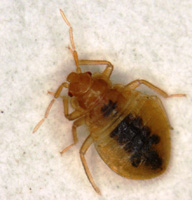
Bed Bug Adult
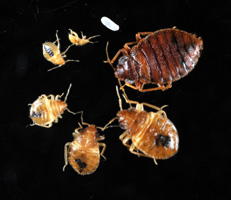
Bed Bug Life Cycle - Adult and Nymph Stages
Where are bed bugs found?
Bed bugs are found throughout the world. They are closely associated with people and can live wherever people spend a lot of time, such as hotels, dorms, homes, apartment buildings, long term care facilities, schools and hospitals. Bed bugs are concentrated in areas where people sleep. Their flattened body shape allows them to hide in small nooks and crannies in the bed, the furniture where people may sleep, or areas very close by such as baseboards, electrical outlets, and even inside appliances.
How do they spread?
Bed bugs are excellent hitchhikers. They can easily move from an infested building to a new site as people move. The recent resurgence of bed bugs is due in large part to international travel. Bed bugs hitchhike on luggage or on personal items or clothing and can move from one country to another in a very short period of time. Within a community, bed bugs can spread when people move infested possessions into a new apartment or home. Purchasing infested, second-hand beds or other furniture has been shown to accelerate local outbreaks of bed bugs. Once inside a building bed bugs can move between rooms or apartments by walking or crawling via hallways, or by squeezing through tiny cracks in common walls, ceilings, or utility ports.
Do bed bugs hurt me?
Bed bugs feed on human blood. They take blood from sleeping people by inserting their mouthparts through the skin and sucking out small portions of blood. Bed bug feeding has not been proven as a means of transmitting diseases, however recent research has shown that bed bugs can carry drug resistant bacteria (MRSA) on their bodies. At the very least bed bug feeding is a disagreeable process. Bed bugs feed on exposed skin (neck, arms, legs, etc.) while a person is sleeping. Reaction to the bites varies widely from person to person. Bed bug feeding does not cause immediate pain, so it does not disturb sleep. It is usually only in the morning that people may feel the effects of the bite. For most people, a bed bug bite results in a small, itchy, red, welt similar to a mosquito bite. Some people express more itching and swelling, while others manifest no skin reaction to bed bugs bites at all and therefore are not even aware of an infestation. The most serious result of bed bug feeding is the emotional anguish that is associated with this parasite. The thought of a bed bug feeding on a sleeping person can translate into sleeplessness or into obsessive behavioral compulsions that can be worse than the bed bug bite.
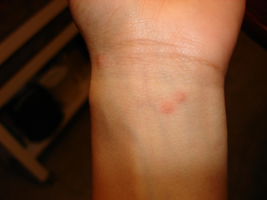
Welt from Bed Bug Feeding
How do I know if I have bed bugs?
Usually, bites are the first sign of a bed bug infestation. Keep in mind, however, that there are other causes of welts and itching. People would do well to verify suspected bed bug bites by inspecting closely for the presence of the bugs themselves or the tell-tale signs that bed bugs leave behind. Use a flashlight to examine cracks and crevices where bed bugs may hide. Look closely for bugs in the sheets, or along the mattress seams, folds or in cracks in the bed frame. If a bug is found, place it in a small bottle and have an expert look at it to confirm that it is a bed bug. Signs of bed bug feeding also include tiny bloodstains or marks on the bed clothing, sheets, or mattresses. Often bed bugs will excrete a small droplet of
blood after feeding. Look in or along mattress seams or other cracks and crevices on or near the bed for evidence of these dark fecal specks. Usually these occur where you might find live bugs or shed skins of bed bugs (cast skins).
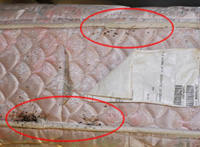
Indications of Bed Bug Infestation
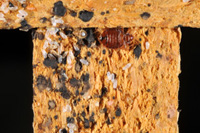
Bed Bug Infestation on a Night Stand
How can I prevent bed bugs from entering my home?
The most valuable form of home protection is becoming aware of the threat of bed bugs. Understand where and how they travel. Know what they look like and how to inspect for them. Be very careful about purchasing or bringing home second-hand upholstered furniture and clothing. Always closely inspect items for signs of infestation. Launder any items that can be laundered in hot soapy water and dry with hot air. Bed bugs will not survive this regime. Make vacuuming, cleaning, decluttering and inspecting a regular habit. Steam or heat treatments must be applied to anything that is suspect, before it enters the house.
How do I protect myself from bed bugs while traveling?
Be alert and aware when travelling. If you suspect bed bug infestations, use common sense and what you know about bed bugs to help avoid bringing them home with you. Inspect your hotel room for signs of an infestation BEFORE you move your belongings in. Some travelers will place their luggage in the bathtub or on a wooden chair or desk rather than on a bed while they perform this inspection. Carefully inspect the mattress seams, headboard, and furniture around the bed for fecal specks, cast skins, or live bed bugs. If bed bugs or signs of bed bugs are found, immediately report this to the registration desk and ask for a different room. When returning home, carefully check luggage seams and clothing for any signs of bed bugs before bringing it into your home. Clothing can be immediately washed and dried to ensure that no bed bugs will hitchhike on it. If other possessions and luggage are found to have bed bugs on it, do not take them into the home. Arrange for heat or other reliable treatment of the articles in question.
How do I inspect a hotel room for bed bugs?
Checking into hotel rooms:
Remember the old addage ‘an ounce of prevention is worth a pound of cure.’ This has never been more true than in our battle with bed bugs. Avoiding them in the first place is the best prevention.
When checking into a hotel ask if bed bugs have been found there or if treatments for bed bugs have occurred.
Once at your room, do not put your luggage, coat or personal belongings on the bed. Rather use luggage racks, table tops, leave at front door/hall, or place in bathtub upon entry.
Thoroughly inspect the room before unpacking.
Inspection Steps:
- Use a flashlight.
- Remove top comforter (this seldom receives the laundry regime that sheets do).
- Pull back the hotel bed sheets and inspect the mattress seams, particularly the corners, for telltale brownish or reddish specks (fecal specks).
- Look behind the head-board if possible, paying close attention to tight cracks and crevices.
- Inspect folds, cracks and crevices of furniture near the bed.
- Inspect the carpeting and base boards nearest to the bed.
If you suspect a bed bug infestation, contact the management – ask to be moved and not just next door.
Returning home from a bed bug infested area?
Remember that providing an opportunity for a hitch-hiking bed bug to move from bed to bed, is the most likely route of re-infestation.
When you return home from an infested residence, thoroughly inspect and vacuum your suitcases, purses, hand bags and any other goods that have been with you before bringing them into the house.
Place all of your clothing in sealable plastic bags and take them directly to the laundry. Wash all your clothes (whether used during the trip or not ) in hot soapy water and dry in a clothes dryer set on high heat. This includes the clothes that you are wearing. Strip at the door and place your clothing in a plastic bag.
Use a large plastic bag to contain your luggage and store in an area not commonly used (garage or storage closet) – not under bed or even in your bedroom.
Shoes and other non-washable items can be placed in a box or bag and then moved to a freezer or ‘pack-tite’ for temperature treatments.
If I find bed bugs, what should I do?
If you have found and confirmed bed bugs in you home, follow these simple steps.
DO NOT:
- Do Not panic. Remember that these pests are not life threatening. It is likely that they have been present for some time. They reproduce quite slowly, so you have time to organize and develop a logical yet aggressive treatment strategy.
- Do Not assume that they are present because of uncleanliness or poor housekeeping. These are parasites of people and may be found wherever people live.
- Do Not automatically discard furniture or other items. This is often unnecessary and moving furniture often leads to spreading bed bugs.
- Do Not purchase or use chemicals that are not labeled for Bed Bug control. Home remedies and concoctions are likely to have little effect on the bed bugs but can have detrimental health effects on you, your family or your home.
DO:
- Remain calm. Know that bed bugs, although difficult to control, can be eradicated from your home if you follow a well thought out and executed plan.
- Inspect and monitor. Determine where and how widespread the infestation is. Use of traps such as Climb-Up Interceptors® is an efficient method of monitoring.
- Intensify cultural practices. Clean, launder, vacuum, remove clutter. Do not move furniture from room to room. Maintain good travel practices. Remember that just like you would not want others to bring them into your house, be sure that you give others the same respect. Use steam treatments, mattress encasements, and inorganic powder treatments as part of your treatment strategy.
- Contact a professional pest manager who has experience in controlling bed bugs using integrated pest management. Work closely with them in preparing the home for treatments and in following up afterwards. Researchers have found that how residents work and cooperate with the pest control provider can make the difference between an easy eradication and a long drawn-out process.
How do I properly dispose of bed bug infested furniture?
When bed bug inspections reveal that a bed or other piece of furniture is infested with bed bugs, home owners often panic and seek to immediately discard the furniture.
There are times that furniture should be discarded but certainly not always. Remember that bed bugs can be eliminated from beds or stuffed furniture using control methods mentioned later. In most cases there is no need to throw expensive furniture out.
Having said that, there are situations when a heavily infested piece of furniture might best be simply disposed of. Just how that is done is critical to prevent the spread of bed bugs.
Furniture moving is most often a two man job. When it comes to bed bug infested furniture, this is even more true.
Before you even begin to move the furniture, make a sound plan as to how and where the furniture can be moved easily and safely.
Remove bed bug infested furniture from a home or apartment with ‘containment’ in mind. The goal is as much to prevent the spread of the bugs, as it is to be rid of the furniture. To do this you must ensure that all bugs are contained inside the furniture on the way to the dumpster. This is best done by wrapping the chair or couch in plastic. Drop cloths are inexpensive large sheets of plastic that can be wrapped around the furniture and sealed with tape. Be sure to seal up any openings or tears so that the bugs cannot fall out as the furniture is loaded, tipped and carried down hallway, stairs and through doors.
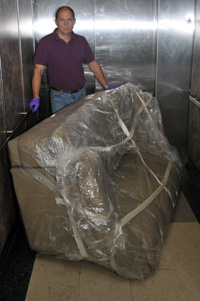
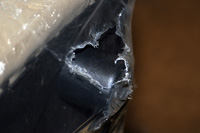
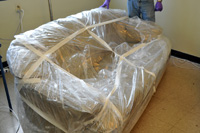


Once the furniture is successfully removed from the building it is the final responsibility of the owner to ensure that the furniture is not picked up by another and taken into another home or apartment, thereby spreading the bed bug infestation. The best way to assure that this does not occur is to render the furniture unusable. Breaking the wooden framing and slashing the fabric with a utility knife are two effective ways of doing this. Further, ensure that others know that the furniture is infested by marking it as such before you leave it to be discarded.
What can I expect from a pest management professional?
First, understand that control of an infestation can be difficult and will require time. Professional pest managers are trained to apply treatments that involve heat or pesticides. During the control process, total cooperation from the resident or homeowner is needed. A pest management professional will inspect to determine the location of the infestation and how large it is. Bedding and infested materials should be laundered at the time of treatment and on a regular basis afterwards, using hot water, soap, and hot temperature clothes dryers. Stuffed animals, backpacks, and shoes can be treated the same.
How can I help get the bugs out?
Non-chemical treatments are often also necessary to eliminate the infestation whether used alone or in conjunction with professional chemical control methods. These are often best applied by the homeowner or resident. Two excellent non-chemical methods are (1) using mattress and box spring encasements and (2) using steam machines. Encasements are designed to fit around a mattress or a box spring. They are zippered shut and will contain bed bugs that are located inside. They also will prevent bed bugs from entering the mattress. Encasements improve control and reduce the risk of spread, but they will not eliminate an infestation, especially if bed bugs are located in any other place. Steam machines and heat treatments are effective for killing bed bugs. Reduce clutter to improve detection and treatment effectiveness.
Why is bed bug information needed?
Bed bugs are a common problem very few people know much about. They are becoming more and more common because people do not understand their biology and how they move. As a result, the bed bug resurgence throughout the nation continues. Experts believe that this epidemic has only just begun and that it will continue until the general public becomes aware, incorrect information is replaced by facts and proven local and national programs are designed and implemented to stem the tide of the bed bug resurgence.
Where Can I Get Help?
Besides Purdue University, there are a number of state agencies that can provide valuable bed bug information. Often Extension is the front line of this information. For your convenience, All Things Bed Bugs provides a list of extension personnel by state and by county that may help you make direct contact with a local knowledgeable person.
What is a Bed Bug detecting dog and are they effective?
Why Dogs:
In addition to being extremely intelligent, dogs are blessed with some senses much more powerful than those of humans. In particular, their sense of smell is extraordinarily well-developed.
Smell is the dog’s dominant sense, so much so that a huge part of its brain is devoted to analyzing odors. Some estimate that a dog’s sense of smell is 100,000 times better than a human’s. In tests dogs have been able to pick up chemical solutions that form one or two parts in a trillion.
This ability to smell has led to the use of dogs to detect small odors at great distances over long periods of time. Dogs have been trained to track people and animals as well as to detect everything from drugs, bombs, underground gas pipelines, fugitives, cadavers, mold, and termites and most anything hidden. Recently a number of dogs have been trained to assist in the detection of bed bugs.
Bed bug detection dogs have been trained to find and ‘alert’ on the specific smells that bed bugs make. They make excellent bed bug inspectors and can quickly go into and under furniture much easier than can a person. This makes the dismantling of the furniture unnecessary. For example, a dog can climb onto a sofa or a bed and can also get under a bed and alert on bugs inside the box spring without an inspector having to take the couch apart or even take the mattress and box spring off. The same is true for carpeting, baseboards, and electrical outlets.
Canine Inspection Advantages:
The main advantage of a canine inspection is that a dog can inspect a room in a matter of minutes whereas visual inspection, even by trained inspectors, can take hours. Canine bed bug detection is especially well suited for large scale premises where visual inspections are simply not practical, such as whole homes, floors of hotel guest rooms, college dormitories, entire apartment complexes, movie theaters, schools, or infestations in office buildings.
An example of a Canine Inspector:
Meet Dixie. She is a well-trained canine inspector and has been trained to find bed bugs. She is owned by Cobine Dog Knows Detections Service LLC based in Bloomington Indiana.
Dixie is not only a beautiful dog and family pet but she has been professionally trained to find bed bugs.
For demonstrations purposes, live bed bugs (placed in small glass vials with screened tops such that scents can escape but bugs are contained) are hidden in strategic locations around a home without the dog knowing.
Dixie is then asked to search for bed bugs.
Notice that the dog works by sniffing in all areas when she is directed by her handler. When she smells live bed bugs, she will immediately alert her handler by lying down (other dogs may use a different alert sign but it will be very obvious to the handler).
Here bugs are hidden beneath a couch seat. You can see how she puts her nose into the folds and corners and junctions of the furniture.
If she alerts to or points out a bed bug find the dog handlers will then reward her and mark the location where she has alerted to. Human inspectors will come back later to verify the find and then to decide on a treatment plan.
Canine detectors are so efficient that they sometimes can even detect a bed bug infested room without entering it. Here you can see Dixie alerting to smells coming from a vial hidden inside a closet.
Canine Detection Limitations:
Keep in mind that, like any other inspection tools, canine bed bug detection has limitations and is not always fool-proof. Scent dogs depend on their noses, so their “inspection” is limited by what they can smell. Sometimes, airflow can limit what the dog can smell and airflow problems can allow the dogs to miss finding an infestation. Other odors also can mask or interfere with the odors that the dog is trying to detect.
Dogs are no different than people in that they can become tired and make mistakes.
Dogs can be distracted from their task by things such as other animals, food or people interfering. For that reason some simple preparations should be made to ensure that the dog has the best chance of doing its job correctly.
Preparation tips:
All pets must be removed, or placed in an area not involved in the search (example: outside or a bathroom).
Food, water, and toys need to be removed or non-accessible to the search dog.
Noise and human distraction must be minimized. The less human interaction with the canine the better he can work.
Air conditioners, heaters, and ceiling fans need to be turned off 20 minutes prior to our inspection. Windows must be closed.
Air fresheners, plug in air fresheners, and candles should be removed 20 minutes prior to inspection.
Smoking materials must be extinguished within two hours of inspection.
Make sure no pesticides or chemicals have been used 30 days prior to our inspection.
Dog Handler responsibilities
As with any inspection tool, it is unwise to put all of your trust in the dog. Human inspectors or monitors must confirm the presence of live bugs or viable eggs in the area that the dog indicated. It is incumbent upon professional dog handlers to verify the dog’s alert. Therefore, bed bug dog handlers themselves must be knowledgeable about bed bugs. When a dog alerts to a site, handlers must validate the alert by inspecting themselves. To confirm the dog’s findings a very in depth inspection involving removing the mattress and box spring, taking off the outlet switches, pulling up the carpet in places, removing the baseboard in spots, and dismantling the furniture may be required. This may be restricted to just those areas where the dog alerted.
Another method of validating the dogs findings is to use other tools such as bed bug interception devices, CO2 traps, or other detection traps such as the climb-up interceptor trap.
If it is truly a live bed bug, the alert is considered verified and that information should be given to the customer and/or the pest management professional.
What happens if a dog indicates that you have bed bugs?
Ultimately, the presence of bed bugs must be dealt with in one form of treatment or another. Remember that dogs may 'detect' bed bugs only - they do not solve the bed bug problem. The bed bug treatment is independent and must come afterwards.
How widespread is the Bed Bug problem?
Anyone can get bed bugs. Even the cleanest living environments can support bed bugs. Bed bugs are found world-wide. Every city in the United States has bed bugs. Some have more reports than others but the reality is that these pests have become very widespread even on our country.
Because of their nature and where they live, these pests spread very quickly but are difficult to find and treat effectively. Effective management requires combined efforts on the part of the resident, the building manager and the Professional pest management provider.
What is Bed Bug Integrated Pest Management?
Learning about the biology of bed bugs and their association with homes, apartments, hotels, and lodging establishments is the first step in making informed decisions about health risks, and bed bug prevention. Knowing what bed bugs look like, where and how they live, how they bite, how to protect against them when traveling, how to prevent their spread and how to control bed bugs in a residence or lodging establishment once they have infested, are all critical components of Integrated Bed Bug Management.
Once an infestation has been identified decisions have to be made about what control tactics should be applied. Integrated Pest Management involves the judicious selection of multiple methods of control that are all brought together to effect control of the bed bugs. These include, monitoring, cultural controls such as de-cluttering, washing and drying clothes and bedding, as well as the use of pesticides of various types. Studies have shown that when many of these control tactics are brought to bear on a bed bug infestation, control can be achieved.
What are Signs of Bed bug infestations?
Bed bug bites are difficult to identify because the symptoms are similar to other bites or rashes. Catching the bugs red-handed is the most certain way of proving infestation.
Three signs of bed bug infestations are:
- Finding the bed bugs themselves. Be aware of what live bed bugs look like.
- When bed bugs grow, they cast off their outer shell or skin. Often piles of these shed skins are evidence of a bed bug infestation.
- When bed bugs feed on blood they excrete a portion of the blood at the feeding site, on the sheets or in places where they congregate such as on mattress folds. These are called blood smears or specks and are evidence of bed bug infestations.
What About Bed Bugs and MRSA?
Certain staphylococcus bacteria (MRSA) have been shown to be highly resistant to methicillin antibiotics. Recent research has shown that these drug-resistant (superbugs) germs can be carried on the bodies of bed bugs. This is not surprising given that MRSA is most commonly found in hospital settings. What should be more shocking is the fact that bed bugs are now known to infest hospitals.
Also keep in mind that the fact that they can physically carry germs on their body is not the same as being able to transmit them biologically. There is no evidence to suggest that MRSA can be injected via saliva into a sleeping person from a bed bug.
At least 27 other agents of human disease have been found on bed bugs, including viruses, bacteria, protozoa, and parasitic worms. None of these agents reproduce or multiply within bed bug bodies and very few survive for any length of time inside a bed bug.
The bottom line is that there is no evidence that bed bugs are involved in the transmission (via bite or infected feces) of any disease agent, including hepatitis B virus, MRSA, HIV, or the virus that causes AIDS.
Heat and bed bugs
Continual exposure of bed bugs adults and nymphs to temperatures below freezing and short term exposure (1 – 3 h) to temperatures below −16 to −18 °C results in mortality.
The upper thermal limit for short term exposure of eggs, nymphs and adults is between 40–45 °C for the common bed bugs (Cimex lectularius). Long-term exposure to temperatures above 35 °C results in significant reduction in survival of mobile bed bugs.
Eggs for C. lectularius and C. hemipterus are no longer viable when held below 10 °C or above 37 °C throughout embryogenesis.



